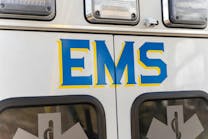If you haven’t had to perform CPR for a patient who was being shocked by an automated implantable cardioverter defibrillator (AICD), give it time. Approximately 800,000 people in the United States have AICDs, and 10,000 new devices are implanted each month. Despite the large numbers, some EMS systems lack specific guidelines for managing a patient in cardiac arrest when an AICD is firing, and others have guidelines that might not be clear. Furthermore, some EMS myths need to be busted.
A few fallacies
You can’t perform normal compressions, because the device could damage the heart. The American Heart Association (AHA) clearly states that chest compressions can be performed as usual in the presence of an AICD. This also would mean not interrupting compressions because of a shock: Complete each two-minute cycle before each pulse check.
You shouldn’t shock a patient with an AICD, because you could damage the device. Although it’s true that CPR can damage the device, the alternative is to do nothing, which virtually ensures that the patient will die. The device always can be replaced. Furthermore, positioning the electrode pads in a clinically acceptable position that isn’t right over the device can reduce significantly the likelihood of damaging it.
If the rescuer is performing compressions when the AICD defibrillates, the rescuer will be shocked, too. There is no danger to the rescuer who wears gloves, but rescuers who lack gloves might feel a brief, unpleasant, tingling sensation.
Providing external defibrillation on top of the internal defibrillation can cause more harm than good. AHA recommends allowing 30–60 seconds for the AICD to complete its therapy cycle before administering an external defibrillation. If the device is firing so often that this isn’t possible, the AICD likely is ineffective and external defibrillation must be provided.
Provisions of good CPR
Years of prehospital cardiac arrest research established that the true key to maximal likelihood of resuscitation success is high-quality, minimally interrupted chest compressions. The presence of an AICD (firing or not) should in no way affect the provision of good CPR. Many EMS agency guidelines direct rescuers to provide external defibrillation if the internal AICD defibrillation isn’t effective. The key is determining whether the shocks are effective, particularly if the patient arrests in front of you. The effectiveness of the AICD defibrillation can be determined by closely monitoring the ECG rhythm. If the AICD defibrillation is effective, there should be a short period of post-shock asystole while the heart’s electrical system resets. However, if there is no substantial change in the cardiac rhythm after the AICD shock(s), then the AICD isn’t effective. External defibrillation should be attempted immediately if the rhythm is ventricular fibrillation or pulseless ventricular tachycardia. If a pulse isn’t returned after two internal AICD defibrillation cycles, then external defibrillation should be considered.
Additionally, medications should be administered according to local guidelines. For example, if a protocol calls for epinephrine after a second shock, then that medication should be given after the second shock, whether it’s delivered internally (AICD) or externally. It doesn’t matter whether the energy comes from an internal or external source. Similarly, all other cardiac arrest therapies should be given based on the cardiac rhythm, not based on the source of the defibrillation. Of course, all treatment decisions should be made in coordination with medical direction and local guidelines.
As AICDs become more prevalent, medics must understand how they operate and how to manage a patient who has such a device. If the patient has been in prolonged cardiac arrest for several minutes prior to EMS arrival, then the AICD hasn’t been successful, and routine cardiac arrest management should be appropriate.
Two other tidbits: AICDs are not pacemakers, but some patients have both, and an AICD may shock a conscious patient. Agencies should work with their medical director to develop and implement clear guidelines for treating cardiac arrest patients who have an AICD, for both EMS-witnessed and EMS-unwitnessed arrest. No one wants to be shocked by a situation that occurs on scene.

Tami Kayea | Firefighter/Paramedic
Tami Kayea has been a firefighter and paramedic with Dallas Fire-Rescue Department for 22 years. She has risen through the ranks and is currently a deputy chief. Kayea holds a master’s degree in management and leadership and is a graduate of the Executive Fire Officer Program through the National Fire Academy.






